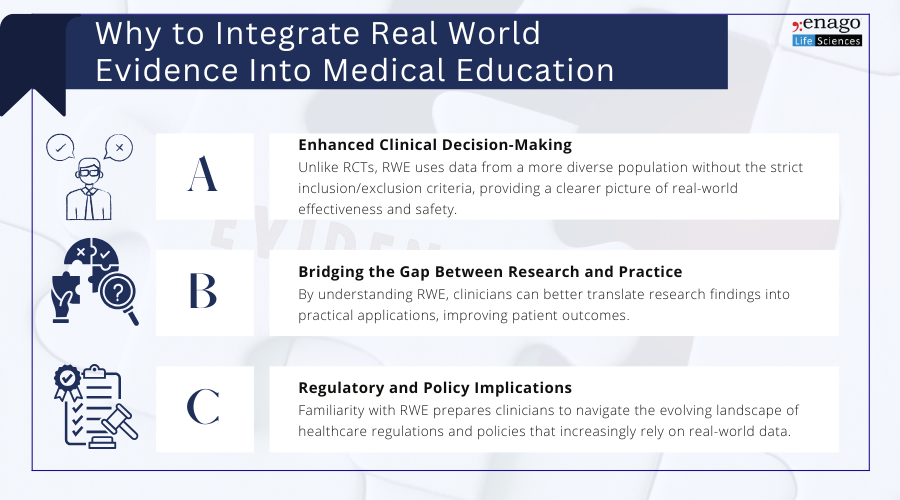Integrating Real-World Evidence into Medical Education and Training: Preparing Tomorrow’s Clinicians for Data-Driven Care
In an era where personalized medicine and data-driven decisions are paramount, Real-World Evidence (RWE) has emerged as a cornerstone in healthcare. Derived from Real-World Data (RWD) such as electronic health records (EHR), wearable device or mobile health app data, insurance claims, and patient-reported outcomes, RWE offers insights into the effectiveness, safety, and utility of medical interventions in routine clinical settings. As regulatory bodies like the U.S. Food and Drug Administration (USFDA) and the European Medicines Agency (EMA) increasingly incorporate 098 RWE into decision-making processes, it’s imperative that medical education evolves accordingly. Training the next generation of clinicians must go beyond the conventional textbook and clinical trial paradigms to include real-world insights that mirror everyday patient care.
What is Real-World Evidence?
The FDA defines RWE as “the clinical evidence governing the usage and potential benefits or risks of a medical product derived from analysis of RWD.” Unlike randomized controlled trials (RCTs), which operate under controlled environments, offers a broader perspective on patient outcomes and treatment efficacy.
Importance of Integrating RWE into Medical Education
As healthcare shifts towards value-based models, the ability to interpret and apply RWE becomes a critical competency for clinicians. Medical education must, therefore, incorporate RWE to prepare students for the complexities of modern clinical decision-making. Key reasons include:

RWE has increasingly been used in drug approval processes, supplementing data from RCTs. For example, the FDA approved the use of palbociclib, based on data. This shows how . Furthermore, RWE plays a crucial role in post-marketing surveillance, identifying adverse drug reactions and long-term effects that were not captured during clinical trials.
Applications of RWE in Clinical Practice and Learning
To truly prepare tomorrow’s clinicians, educational programs must move from theoretical endorsement to practical integration. Embedding RWE in medical training creates opportunities for experiential learning and clinical relevance. It opens doors to real-world use cases, such as:
- Clinical decision-making tools powered by real-time data
- Comparing how well drugs work using data from patients outside the clinical trial
- Post-marketing surveillance and long-term safety tracking
- Patient adherence trends and analysis of social determinants of health
- Evidence generation for rare diseases and underrepresented populations
Challenges and Considerations
While integrating RWE into medical education offers numerous benefits, it also presents challenges like:
1. Data Privacy and Ethics
Educators must address concerns related to patient data confidentiality and ethical use of real-world data. Future clinicians must be trained to handle sensitive data ethically, with a deep understanding of HIPAA, GDPR, and institutional policies.
2. Resource Allocation
Developing and implementing RWE-focused curricula require investment in faculty training and technological infrastructure. Since most medical curricula currently lack a focus on data literacy, implementing RWE education requires substantial investment in faculty development and digital infrastructure. Furthermore, it will also require the incorporation of interdisciplinary training modules developed in collaboration with data scientists, biostatisticians, and health informatics experts to ensure that future clinicians are not only exposed to RWE concepts but also understand how to work alongside data professionals to interpret and apply real-world insights effectively.
3. Standardization
Establishing standardized methodologies for teaching and assessing RWE competencies is essential to ensure consistency across institutions. Accreditation boards and medical councils must align learning outcomes.
4. Missing Data and Bias
Missing data due to inconsistent data collection can lead to biased patient selection, distorting study outcomes. Selection bias may also arise from different treatment regimens prescribed based on disease severity, further complicating the accuracy of findings.
Strategies to Overcome Challenges
1. Regulatory Frameworks and Guidelines
Regulatory bodies like the are actively establishing guidelines to streamline RWE generation. The USFDA’s draft guidance on RWD submissions is an important step in standardizing processes, while initiatives like the ISPOR Real-World Evidence Transparency Initiative are pushing for greater transparency in RWE studies. Medical educators can use these frameworks as teaching tools to align learning with industry standards.
2. Data Quality Improvements
Development of advanced data collection techniques and digital health solutions can improve the quality of RWE. AI technologies such as machine learning and natural language processing (NLP) can help with the analysis of unstructured data, such as electronic health records (EHRs), to gain better insights.
The Role of Industry and Medical Communications
Global leaders in medical communications like Enago Life Sciences play a crucial role in this educational shift. By partnering with healthcare institutions and biopharmaceutical companies, Enago provides evidence-based training resources, RWE-driven content development, and tools that support medical professionals in lifelong learning. These partnerships can accelerate the integration of RWE into continuing medical education (CME), residency programs, and academic curricula.
The integration of Real-World Evidence into medical training is not merely an academic exercise but a necessity in preparing clinicians for the realities of modern healthcare. By embracing RWE, medical education can produce practitioners who are adept at navigating complex data landscapes, ultimately leading to improved patient care and outcomes.
Author:

Anagha Nair
Editorial Assistant, Enago Academy
Medical Writer, Enago Life Sciences
Connect with Anagha on LinkedIn

